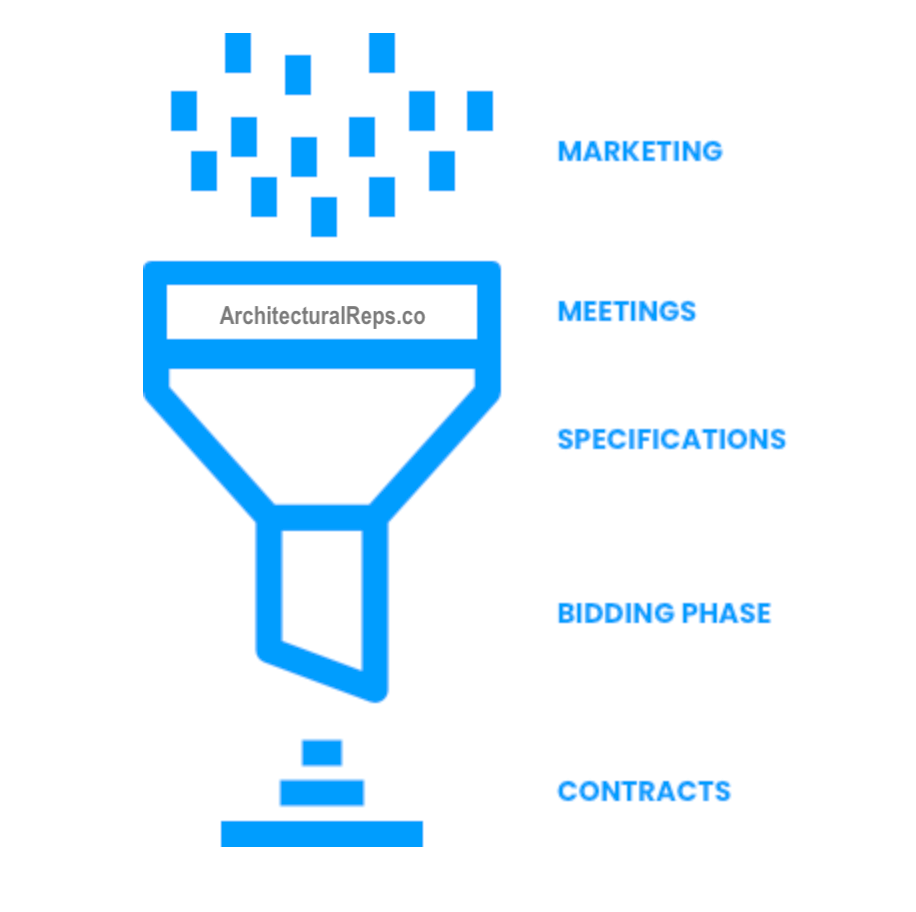
The five stages of architectural sales = ROI
If you’re new to architectural sales, you may wonder, how does this all work? It’s a fair question that nearly every building product manufacturer has explored before, during, and after building an architectural sales force.
Architectural sales teams operate differently than traditional sales in that architects and designers don’t buy products; they specify them. So architectural reps spend most of their time introducing products, gathering feedback, and facilitating requests from architects and designers to build enough interest to specify it on a project.
You could think of architectural sales as a funnel or hourglass of sand. Specifications (sand) are opportunities that must be pushed down the funnel using a stage.
The five stages of architectural sales are a blueprint for a better sales process—the better your approach to each stage, the better odds of a massive return on investment.
Stage 1 – Marketing
In construction, the best way to market your products to contractors is to get specified on projects. Getting specified requires you to market to architects (and owners) with a need for your products.
Do all architects specify your products? That is usually a no. Architects that design schools have no interest in curtains. However, they are interested in polished concrete, windows, roofing, and tiling products. So you have to know your audience.
A building product manufacturer’s architectural rep (or specifier) needs to identify where to spend their time and who needs your products. Once the need is determined, then you have a potential specification opportunity.
Stage 2 – Meetings
Architects are busy people, and every building product manufacturer is fighting for their attention. Making it much more difficult for new manufacturers to schedule meetings.
More prominent brands usually hire a fleet of architectural sales reps to become “trusted advisors” to the architect. Trusted advisors are the architect’s go-to person for gathering information or trusted feedback on a subject, product, or assembly.
Becoming a trusted advisor can be difficult if your product or rep is new to architectural sales. Working with an experienced architectural representative can make this process faster and more efficient.
Stage 3 – Specifications
Getting specified on a project will become a sales lead. It’s like a billboard on a freeway that every car (contractor) will see as they interact with the construction project.
The more specifications you create with architects during your meetings, the more calls and estimate requests you will receive from contractors.
If the architectural sales team can create an office master specification with the architect, it has the potential for indefinite life cycle, meaning that once an architect specifies your product, it may continue to be specified on future projects.
Stage 4 – Bidding
To gain a return on investment, you have to locate the project during the bidding phase and what contractors are bidding the project.
Specifications during the bidding stage are a “warm” lead that requires an estimate and follow-up to close the deal.
At this stage a traditional sales team will need to work with distributors, installers, and general contractors. It’s the most critical stage for gaining a return on investment from your architectural sales team.
Stage 5 – Contracts
A large pipeline of projects will help your team close more deals and build momentum. The more specifications you create will increase your bid requests and the more likely you’ll gain a return on your investment from the architectural sales process.
Contracts are the return on investment for an architectural sales team!
4 Comments
-
It is true that architects are very busy people. This makes it very difficult to get an appointment or at the least, get their attention. I have used lunch and learn presentations to network with architects, but that becomes very expensive. Many of the manufacturers don’t want to contribute to the price of lunch since they have salespeople throughout the country. Those costs can blow through a marketing budget very quickly.
Do you have any suggestions to get the opportunity to introduce ourselves to architects in an effort to promote our products?-
Author
Hi David,
There are a few ways to reach architects without a lunch presentation. Once you have identified that a firm is a good prospect for a specific product line, it’s time to reach out to them with a “what’s in it for them” approach. This can be accomplished by using “anchor” brands to open the door and start the discussion for all other brands you represent.
-
-
A less expensive, but sometimes equally effective way is to offer “Coffee & Bagel Breaks” in the morning, and “Ice Cream Sandwich” (or other type) snack breaks in the afternoon. The Key is to get to know and befriend the GATEKEEPERS – the Admins who control the master schedule and can help you book a room, etc. But I agree – getting in front of them face-to-face is absolutely essential!
-
Author
Lee, Thank you for sharing your experience.😀
-
